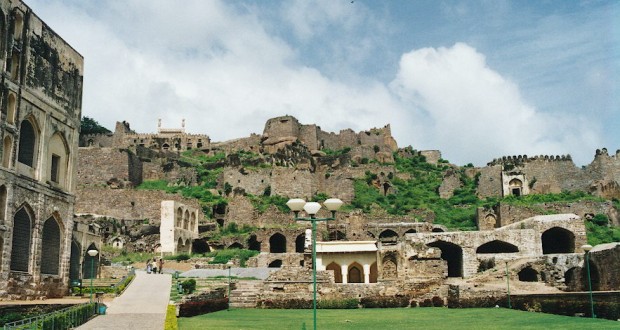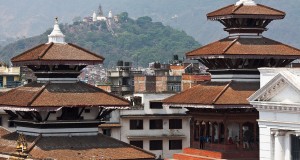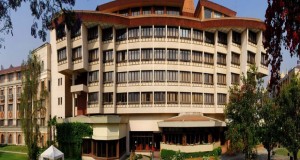Hyderabad is effectively two cities in one, though the new city of Secunderabad (to the north) is of minimal tourist interest. All the sights, the hotels, the action and the bazaars are concentrated in the Abids area of Hyderabad town, directly south of Hussain Sagar, and north of the Musi River.
The city itself is a busy, bustling and sprawling complex where new multi-storeyed 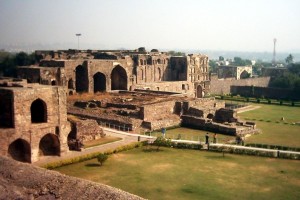 buildings and wide modern streets contrast strongly with narrow medieval lanes and backstreets, and where the smoke of modern industrial factories meets the dust of busy roadside cottage workers, turning out some of India’s finest handmade crafts. It is a friendly, active place, with a great deal to see and do.But the traffic is suicidal. In the city centre, you need nerves of steel to get around L on foot. ‘Daydreaming is dangerous’, cautions one traffic sign. Hyderabad has overcrowded city buses, crazed auto-rickshaws which stop for absolutely nothing (Rs2.5 per km), and a few maniacal taxis (Rs5 per km, metered).
buildings and wide modern streets contrast strongly with narrow medieval lanes and backstreets, and where the smoke of modern industrial factories meets the dust of busy roadside cottage workers, turning out some of India’s finest handmade crafts. It is a friendly, active place, with a great deal to see and do.But the traffic is suicidal. In the city centre, you need nerves of steel to get around L on foot. ‘Daydreaming is dangerous’, cautions one traffic sign. Hyderabad has overcrowded city buses, crazed auto-rickshaws which stop for absolutely nothing (Rs2.5 per km), and a few maniacal taxis (Rs5 per km, metered).
For worry-free travel, use the tourist taxi service offered by A.P. Travel & Tourism Dev. Corp., Gagan Vihar, Mukhram Jahi Rd (tel 556493, 556303) or your hotel. For out-of-town trips, cycling is pleasurable and cycles can be hired for Rs10-15 per day from several places; your hotel can advise). If biking around in town, make sure you have some decent insurance. City conducted tours are far too hurried, but they are a useful introduction and orientation. Then you should tour Hyderabad independently, allowing a minimum of 2 days for sightseeing and shopping. The traffic in the old city is often chaotic, and downright dangerous; ride wherever possible, and avoid walking across main roads. If you need a badge-carrying guide, contact A.P. Dept of Tourism, Lidcap Building, Himayatnagar (tel 223384, 223385).
Old City Tour (by auto-rickshaw/taxi, 4-6 hours)
Golconda–Mecca Masjid–Charminar–Salar Jung Museum-Birla Mandir Temple–Birla Planetarium
Set out for Golconda Fort early in the morning. It lies 11 km (7 miles) west of Hyderabad, and takes about 40 minutes by rickshaw (Rs60-70 return, plus a waiting charge of Rs5 per hour while you sightsee). Going by taxi takes slightly less time but doubles the cost. The fort lies in a very dry, exposed situation, so wear a hat/scarf and long-sleeved shirts. There are about a dozen good English-speaking guides at the fort entrance. It’s not a bad idea to establish their fee in writing before you set out; you can pay them more if they’re worth it, 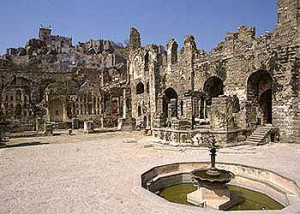 which they usually are. The inner fort of Golconda is 25 km (16 miles) around, and you can tour its various palaces, audience rooms, baths, armoury and mosques comfortably in 1 1/2 hours. If you wish to wander round on your own, buy the good little Golconda guide book with map, printed by Commercial Book Depot, Charminar, and available in many Hyderabad bookshops.
which they usually are. The inner fort of Golconda is 25 km (16 miles) around, and you can tour its various palaces, audience rooms, baths, armoury and mosques comfortably in 1 1/2 hours. If you wish to wander round on your own, buy the good little Golconda guide book with map, printed by Commercial Book Depot, Charminar, and available in many Hyderabad bookshops.
Golconda is the biggest fort in south India. It is made of solid limestone, and took several thousand labourers, working day and night, 62 years to build. Founded in the 13th century by the Kakatiyas of Warangal, it was originally just a small hilltop fort with mud walls. Its name derived from the words Colic meaning ‘shepherd’ and Fonda meaning In 1512 it became the capital of the Persian Qutb Shahi kings, who expanded the original structure into a massive fort with battlements and crenellated walls of granite some 5 km (3 miles) in circumference. Like so many Indian forts, Golconda finally fell to treachery rather than to arms, a treacherous Qutb Shahi general letting the Mughal emperor Aurangzeb in the front (‘victory’) gate in 1687 after a siege lasting 8 months. Thereafter the legendary fort and its famous diamond market went into decline, hands in the centre porch can be heard at the fort’s highest point, the Bala Hissar, 380 steep steps above. This device was contrived, it is believed, to convey any message regarding visitors to the topmost guards. Behind this echo chamber is a purple-blossomed tree, very popular with local people. They use its hard-wood bark for cleaning their teeth.
Your guide will take you up into the fort via the ‘common passage’, leading past the armoury on your left; the mortuary bath where dead royals had a ceremonial dip before being buried, to your right; and the bodyguard barracks, with adjoining two-storeyed building used by the court ministers Akkanna and Madanna, also to your left. An ascent of 360 steps now begins, leading up to the Bara Dar (General Assembly Hall). On the ascent you’ll see various deep wells, water reservoirs and watering canals.
Halfway up, you reach the Ramdas Kotha, an old storehouse which became the 12-year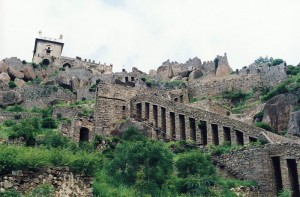 prison of Abdul Hasan Tanah Shah’s chief cashier, Ramdas. He was interred for dipping into official revenue to renovate a nearby temple. It’s a dark, gloomy place, full of the handmade deities (Ram, Lakshman, Hanuman) and faded carvings/paintings of animals and plants which the bored Ramdas made to fill in his time. Past the jail, and just above the Barood Kotha (gunpowder store), there’s a charming little Hindu temple cut into a large natural boulder the shape of a Nandi bull. A little further up is the simple, elegant Mosque of the royal family, built by the third king of the dynasty, Ibrahim Quli Qutb Shah in 1550. In those days, the king prayed in the mosque and his Hindu chief minister in the small rock-cut temple below; it was an age of practical religious tolerance. From the eastern side of the mosque, there’s a beautiful view down over Golconda and across to Hyderabad city.
prison of Abdul Hasan Tanah Shah’s chief cashier, Ramdas. He was interred for dipping into official revenue to renovate a nearby temple. It’s a dark, gloomy place, full of the handmade deities (Ram, Lakshman, Hanuman) and faded carvings/paintings of animals and plants which the bored Ramdas made to fill in his time. Past the jail, and just above the Barood Kotha (gunpowder store), there’s a charming little Hindu temple cut into a large natural boulder the shape of a Nandi bull. A little further up is the simple, elegant Mosque of the royal family, built by the third king of the dynasty, Ibrahim Quli Qutb Shah in 1550. In those days, the king prayed in the mosque and his Hindu chief minister in the small rock-cut temple below; it was an age of practical religious tolerance. From the eastern side of the mosque, there’s a beautiful view down over Golconda and across to Hyderabad city.
From the northern side, you can see the Qutb Shahi Tombs, fully reflecting the glory and pomp of the rich sultans of Golconda, whose last resting-place these are. Finally, you’ll reach the Baradari or Durbar Hall at the summit of Golconda. This is a 12-arched, three-storey pavilion, with a top terrace giving panoramic views of the surrounding fort, and an open-air stone throne called Shah Nashin. Here, the Qutb kings used to sit out on the open terraces, or hold meetings with the royal family or court ministers. The Durbar Hall also has an 8-km (5-mile) long secret underground passage which was used in times of emergency or danger. It is here, from the topmost point of the fort, that your guide will show the effectiveness of the ‘clapping technique, signalling down to the entrance gate for a demonstration.
You’ll probably return down via the King’s Way, which leads to the royal palaces and harem area. In olden days, the king was transported down this path by palanquin. You won’t be, but the descent on foot is a pleasant one. On the way, look out for the fort’s unique water-supply system. Huge tanks filled with water diverted from the Banjara hills 6 km (3 3/4 miles away, and ingeniously raised to the fort b. -system of laminated clay pipes and Persian whels, which moved it al the away to the gardens, waterfalls and hanging gardens near the fort’s summit.
Below, in the beautiful Rani (Zanana) Mahals, the first thing you’re likely to be shown are 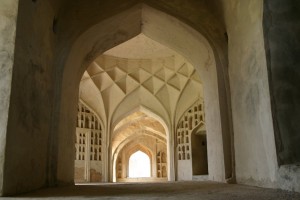 the royal bathrooms. Only then will your guide point out the other attractions of the site. This series of crumbling, complex ruins used to be full of painted, jewelled palaces, arcades, Turkish baths, flower gardens and bubbling fountains. Little remains either of the lovely harem palaces nearby, though the royal kitchen, on the site of the old Camel Stable, is still in good condition. Return via the armoury to the entry gate.
the royal bathrooms. Only then will your guide point out the other attractions of the site. This series of crumbling, complex ruins used to be full of painted, jewelled palaces, arcades, Turkish baths, flower gardens and bubbling fountains. Little remains either of the lovely harem palaces nearby, though the royal kitchen, on the site of the old Camel Stable, is still in good condition. Return via the armoury to the entry gate.
Before going back to Hyderabad, take some time to explore the old town of Golconda, situated within the outer fort walls. In times past, this small bazaar town was a splendid fortress city, famed for its cutting, polishing and marketing of diamonds. The unique Koh-i-noor, now part of the British crown jewels, is said to have come from here. Today, the town is small, yet well-populated, and there are lots of cheap knick-knacks and trinkets being sold.
From Golconda, return to Hyderabad city centre for the impressive Mecca Masj id. This huge white mosque is the finest in south India, and the seventh largest in the world. It was begun in 1614 by Mohammed Quli Qutb Shah, and completed in 1687 by Aurangzeb, the Mughal invader. It derives its name from the few bricks brought from Mecca (and the stone apparently brought from Mohammed’s birthplace) which are embedded in its walls.
Entering the mosque, beware of unsolicited guides. Most are difficult to understand but if you take one on, he should charge about Rs5. Just inside the wide courtyard, on the left, you’ll see a long enclosure full of small marble tombs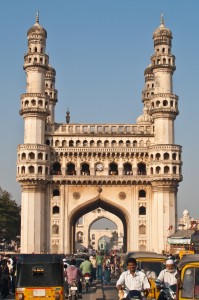 . This is where many of Hyderabad’s wealthy Nizams are interred. The mosque itself is a marvellous structure. Its huge entrance facade is built of a single block of stone, richly inscribed with sayings from the Koran. Within can be seen Portuguese chandeliers, an antique French clock, and inlaid marble flooring. This mosque is the principal place of Muslim worship in the city, and every Friday up to 50 000 people gather for prayers. The huge interior 21.5 m high can accommodate 3000 worshippers, the grounds a further 7000. On important religious days and festivals even the streets outside are filled with kneeling devotees.
. This is where many of Hyderabad’s wealthy Nizams are interred. The mosque itself is a marvellous structure. Its huge entrance facade is built of a single block of stone, richly inscribed with sayings from the Koran. Within can be seen Portuguese chandeliers, an antique French clock, and inlaid marble flooring. This mosque is the principal place of Muslim worship in the city, and every Friday up to 50 000 people gather for prayers. The huge interior 21.5 m high can accommodate 3000 worshippers, the grounds a further 7000. On important religious days and festivals even the streets outside are filled with kneeling devotees.
Just across the road from the mosque you’ll find the Charminar (Four Tower Arch), Hyderabad’s definitive landmark. This imposing arch, deriving its name from its four 56-m high slender minarets, was built in 1591 by Mohammed Quli Qutb Shah, reputedly to commemorate the end of a terrible plague. It stands a watchful guardian over the old city, serenely overlooking the surrounding chaos of anarchic traffic and crowded thoroughfares. A climb of 149 steps up a winding staircase brings you out near the top of the arch, at the tiny second-floor mosque. The high terraced balconies, notable for their profuse stucco decorations, balustrades and noble arches, offer superb bird’s-eye views over the heart of Hyderabad city—busy, bustling scenes of battling rickshaws, thronging pavements, teeming mosques, and colourful bazaars of silversmiths, bangle makers, embroidery shops, perfume merchants and antique dealers. The Charminar is open 9 am-4.30 pm daily, and is beautifully illuminated from 7 to 9 pm in the evenings.
Continuing on by rickshaw or taxi, visit the Salar Jung Museum on the south bank of the Musi River. 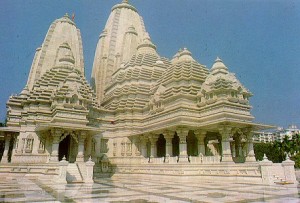 This rather ugly building houses the superb private collections of three Nawabs Salar Jung, successive wazirs or prime ministers of the Nizam of Hyderabad. Salar Jung III died in 1949 without an heir, and the collection was handed over to the Government of India in 1956. The 35 000 exhibits, gathered from all over the world, now fill 35 large rooms. The ornate entrance hall, with its beautiful chandeliers, leads into the ground-floor collection of textiles, Mughal glass, ivory, miniatures and a fascinating bell clock. On the first floor are Kashmir, Burmese, Chinese, Japanese and Western art, and a good selection of bronzes. The prize pieces of the museum are the ivory chairs and the turban of Tipu Sultan, and the swords and daggers of the Mughal emperors. Also of special interest are the small collection of Indian miniature paintings and the fine exhibition of jade. The collection is vast and only a small portion is on display. Open 10 am-5 pm daily (except Friday). Admission Rs2. Free guide service. Photographs not allowed.
This rather ugly building houses the superb private collections of three Nawabs Salar Jung, successive wazirs or prime ministers of the Nizam of Hyderabad. Salar Jung III died in 1949 without an heir, and the collection was handed over to the Government of India in 1956. The 35 000 exhibits, gathered from all over the world, now fill 35 large rooms. The ornate entrance hall, with its beautiful chandeliers, leads into the ground-floor collection of textiles, Mughal glass, ivory, miniatures and a fascinating bell clock. On the first floor are Kashmir, Burmese, Chinese, Japanese and Western art, and a good selection of bronzes. The prize pieces of the museum are the ivory chairs and the turban of Tipu Sultan, and the swords and daggers of the Mughal emperors. Also of special interest are the small collection of Indian miniature paintings and the fine exhibition of jade. The collection is vast and only a small portion is on display. Open 10 am-5 pm daily (except Friday). Admission Rs2. Free guide service. Photographs not allowed.
If you still have the energy, finish off with a sunset visit to Birla Mandir Temple. Set atop a rocky hill overlooking the southern end of Hussain Sagar, this modern Hindu temple, constructed from pure white marble, offers memorable setting-sun views over the city. It’s open 4-9 pm Monday to Friday, 7-11 am and 3-9 pm on Saturday /Sunday. Nearby is the Birla Planetarium, arguably the best in India with its ‘Japanese Technology Sky Theatre’. Admission Rs5. English programmes at 3.30 ands 6.50 pm plus an extra 11.30am show at weekends. Pleasantly air-conditioned, it’s the perfect place to cool off after a steamy day’s sightseeing.

